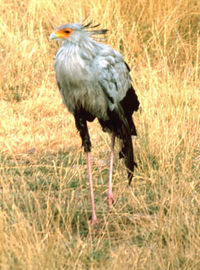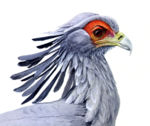|
Secretary Bird Conservation status Least concern[1] |
||||||||||||||
|---|---|---|---|---|---|---|---|---|---|---|---|---|---|---|
 |
||||||||||||||
| Scientific classification | ||||||||||||||
|
||||||||||||||
| Sagittarius serpentarius (J. F. Miller, 1779) |
The Secretary Bird, Sagittarius serpentarius, is an extraordinary bird of prey. Endemic to Africa, this mostly terrestrial bird is usually found in the open grasslands and savannas of the sub-Sahara.[2] It is a large bird of prey in the order Falconiformes, which also includes many other diurnal raptors such as kites, buzzards, vultures, and harriers, but it is so distinctive that it is given its own family, Sagittaridae. The Secretary Bird enjoys a certain fame in Africa, specifically Sudan and South Africa, where it serves as a prominent Emblem on both countries' Coat of Arms.
Contents |
General Appearance

The Secretary Bird is instantly recognizable as having an eagle-like body on crane-like legs which increases the bird’s height to around 1.3 m (four feet) tall. This 140 cm long bird has an eagle-like head with a hooked bill, but has rounded wings.[3] From a distance or in flight it resembles a crane more than a bird of prey. The tail has two elongated central feathers that extend beyond the feet during flight, as well as long flat plumage creating a posterior crest.[4] It likely gets its English name from its crest of long feathers which make it appear to be carrying quill pens behind its ears, as secretaries once did. A more recent hypothesis is that this is a French corruption of the Arabic saqr-et-tair or "hunter-bird."[5]
The genus name, Sagittarius refers to the same feature, but in this case likened to an archer's arrows. Serpentarius reflects the fact that this is a specialist predator of snakes. Secretary Bird flight feathers and thighs are black, while most of the coverts are grey with some being white.[6] Sexes look alike, although the male has longer head plumes and tail feathers. Adults have a featherless red face as opposed to the yellow colored facial skin in young.[7]
Evolution
Recent cladistic analysis has shown Sagittaridae to be an older group than Accipitridae and Falconidae, but a younger divergence than Cathartidae.[8] Studies are still being conducted due to the pecularity of the single species group and recent molecular biology techniques in taxonomic organization.
Habitat
Secretary Birds are endemic to sub-Saharan Africa and are non-migratory (although they may follow food sources).[9] Their range is from Senegal to Somalia and south to the Cape of Good Hope.[10] These birds are also found at a variety of elevations, from the coastal plains to the highlands. Secretary Birds prefer open grasslands and savannahs rather than forests and dense shrubbery which may impede their cursorial existence. While the birds roost on the local Acacia trees at night, they spend much of the day on the ground, returning to roosting sites just before dark.[11]
Diet
The Secretary Bird is largely terrestrial, hunting its prey on foot, and besides the caracaras (such as Polyborus plancus) is the only bird of prey to do so habitually. Adults hunt in pairs and sometimes as loose familial flocks, stalking through the habitat with long strides.[12] Prey consists of insects, small mammals, lizards, snakes, young birds, bird eggs, and sometimes dead animals killed in brush fires. Larger herbivores are not hunted, although there are some reports of Secretary Birds killing young gazelles.[13]
Young are fed liquified and regurgitated insects directly by the male or female parent and are eventually weaned to small mammals and reptile fragments regurgitated onto the nest itself. The above foodstuffs are originally stored in the crop of the adults.[14]
Secretary Birds have two distinct feeding strategies that are both executed on land. They can either catch prey by chasing it and striking with the bill or stomping on prey until it is rendered stunned or unconscious enough to swallow.[15] Studies of this latter strategy have helped construct the possible feeding mechanisms employed by dinosaur-like terror birds that once walked the earth five million years ago.[16]
Reproductive Strategies
Secretary Birds associate in monogamous pairs. During courtship, they exhibit a nuptial display by soaring high with undulating flight patterns and calling with guttural croaking. Males and females can also perform a grounded display by chasing each other with their wings up and back, much like the way they chase prey. They usually mate on the ground, although some do so in Acacia trees.
Rearing of Young
Nests are built on top of Acacia trees, and are usually 5-7 m (15-20 feet) high. Both the male and female visit the nest site for almost half a year before egg laying takes place. The nest is around 2.5 m (eight feet) wide and 30 cm (one foot) deep, and is constructed as a relatively flat basin of sticks.
Secretary birds lay two to three oval, pale-green eggs over the course of two to three days, although the third egg is most often unfertilized. These eggs are incubated primarily by the female for 45 days until they hatch. The Secretary Birds are facultatively fratricidal.[17]
The downy young can feed autonomously after 40 days, although the parents still feed the young after that time. At 60 days, the young start to flap their wings, and by day 65-80 are able to fledge. Fledging is accomplished by jumping out of the nest or using a semi-controlled fall via fervent wing flapping to the ground. After this time, the young are quickly taught how to hunt through expeditions with their parents and are considered independent soon after.[18]
Threats
Young are predated by crows and kites as they are vulnerable in Acacia tree tops.[19] As a population, the Secretary Bird is mainly threatened by loss of habitat and deforestation.[20] In 1968 the species became protected under the Africa Convention on the Conservation of Nature and Natural Resources.[21]
Cultural significance
The Secretary Bird is the national emblem of Sudan as well as a prominent feature on the Coat of Arms of South Africa. In Sudan, It is featured in the middle white strip of the Presidential Flag, as well as being the main object on the Presidential seal and featuring heavily in Sudanese military insignia. The Secretary Bird on the Presidential Flag and Seal has its head turned to the right, with its distinctive crest clearly visible and its wings spread out with a white banner between its outstretched wings reading 'Victory is Ours' - available at [1].
In South Africa, the Secretary Bird, while not the official bird of South Africa, is featured as a symbol on the national coat of arms, represents vigilance and military might, as well as the rise and pride of modern South Africa. [2]
External links
Photos and drawings
- Wordsmith RadioAudio encyclopedia entry about Secretary Bird
- Stock FootageSecretary Bird Stomping on Insect Prey
- Secretary Bird videos on the Internet Bird Collection
Works Cited
Allan, D.G., Harrison, J.A., Navarro, R.A., van Wilgen, B.W., & Thompson, M.W. (1997) The Impact of Commercial Afforestation on Bird Populaion in Mpumalanga Province, South Africa- Insights from Bird-Atlas Data. Biological Conservation, 79, 173-185.
Bortolotti, B.R. (1986) Evolution of Growth Rates in Eagles: Sibling Competition Vs. Energy Considerations. Ecology, 67, 182-194.
Brown, L & Amadon, D. (1968) Eagles, Hawks, and Falcons of the World. Volume 2. New York: McGraw-Hill Book Company.
Curry-Lindahl, K. (1981) Bird Migration in Africa: Movements between six continents. Volume 2. New York: Academic Press.
Dean, W.R.J, Milton, SJ, & Jeltsch, F. (1999) Large trees, fertile islands, and birds in arid savanna. Journal of Arid Environments, 41, 61-78.
Janzen, D.H. (1976) The Depression of Reptile Biomass by Large Herbivores. American Naturalist, 110, 71-400.
Kemp, A.C. (1994) Family Sagittariidae (Secretarybird). Handbook of the Birds of the World. Vol. 2. Eds. del Hoyo, J., A. Elliott, & J. Sargatal. Lynx Edicions, Barcelona. 206-215.
Marshall, L.G. (2004, March 1). The Terror Birds of South America, Scientific American, 82-89.
Mayr, G. & Clarke, J. (2003) The deep divergences of neornithine birds: a phylogenetic analysis of morphological characters. Cladistics, 19, 527–553.
Sinclair, I., Hockey, P., & Tarboton, J. (1993) Illustrated Guide to the Birds of Southern Africa. Princeton: Princeton University Press.
Sinclair, I., & Ryan, P. (2003) Birds of Africa: South of the Sahara. Princeton and Oxford: Princeton University Press.
Footnotes
- ^ BirdLife International (2004). Sagittarius serpentarius. 2006 IUCN Red List of Threatened Species. IUCN 2006. Retrieved on 08 May 2006. Database entry includes justification for why this species is of least concern
- ^ Sinclair, I., Hockey, P., & Tarboton, J. (1993) Illustrated Guide to the Birds of Southern Africa. Princeton: Princeton University Press.
- ^ Brown, L & Amadon, D. (1968) Eagles, Hawks, and Falcons of the World. Volume 2. New York: McGraw-Hill Book Company.
- ^ Brown, L & Amadon, D. (1968) Eagles, Hawks, and Falcons of the World. Volume 2. New York: McGraw-Hill Book Company.
- ^ Kemp, A.C. (1994) "Family Sagittariidae (Secretarybird)", Handbook of the Birds of the World. Vol. 2. Eds. del Hoyo, J., A. Elliott, & J. Sargatal. Lynx Edicions, Barcelona. 206-215.
- ^ Sinclair, I., & Ryan, P. (2003) Birds of Africa: South of the Sahara. Princeton and Oxford: Princeton University Press.
- ^ Brown, L & Amadon, D. (1968) Eagles, Hawks, and Falcons of the World. Volume 2. New York: McGraw-Hill Book Company.
- ^ Mayr, G. & Clarke, J. (2003) The deep divergences of neornithine birds: a phylogenetic analysis of morphological characters. Cladistics, 19, 527–553.
- ^ Curry-Lindahl, K. (1981) Bird Migration in Africa: Movements between six continents. Volume 2. New York: Academic Press.
- ^ Brown, L & Amadon, D. (1968) Eagles, Hawks, and Falcons of the World. Volume 2. New York: McGraw-Hill Book Company.
- ^ Dean, W.R.J, Milton, SJ, & Jeltsch, F. (1999) Large trees, fertile islands, and birds in arid savanna . Journal of Arid Environments, 41, 61-78.
- ^ Janzen, D.H. (1976) The Depression of Reptile Biomass by Large Herbivores. American Naturalist, 110, 71-400.
- ^ Janzen, D.H. (1976) The Depression of Reptile Biomass by Large Herbivores. American Naturalist, 110, 71-400.
- ^ Brown, L & Amadon, D. (1968) Eagles, Hawks, and Falcons of the World. Volume 2. New York: McGraw-Hill Book Company.
- ^ Brown, L & Amadon, D. (1968) Eagles, Hawks, and Falcons of the World. Volume 2. New York: McGraw-Hill Book Company.
- ^ Marshall, L.G. (2004, March 1). The Terror Birds of South America, Scientific American, 82-89.
- ^ Bortolotti, B.R. (1986) Evolution of Growth Rates in Eagles: Sibling Competition Vs. Energy Considerations. Ecology, 67, 182-194.
- ^ Brown, L & Amadon, D. (1968) Eagles, Hawks, and Falcons of the World. Volume 2. New York: McGraw-Hill Book Company.
- ^ Brown, L & Amadon, D. (1968) Eagles, Hawks, and Falcons of the World. Volume 2. New York: McGraw-Hill Book Company.
- ^ Allan, D.G., Harrison, J.A., Navarro, R.A., van Wilgen, B.W., & Thompson, M.W. (1997) The Impact of Commercial Afforestation on Bird Populaion in Mpumalanga Province, South Africa- Insights from Bird-Atlas Data. Biological Conservation, 79, 173-185.
- ^ Brown, L & Amadon, D. (1968) Eagles, Hawks, and Falcons of the World. Volume 2. New York: McGraw-Hill Book Company.




 216.73.216.91
216.73.216.91 User Stats:
User Stats:
 Today: 0
Today: 0 Yesterday: 0
Yesterday: 0 This Month: 0
This Month: 0 This Year: 0
This Year: 0 Total Users: 117
Total Users: 117 New Members:
New Members:
 216.73.xxx.xx
216.73.xxx.xx
 Server Time:
Server Time: